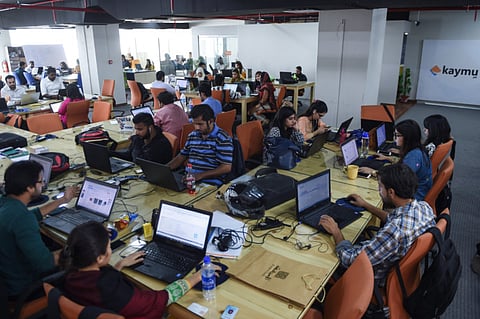Pakistan’s e-commerce sector set for expansion
Valued at $60m, the market is expected to cross $1b by 2020 spurred on by FDI

The 2014 Pakistan Startup Report insisted it was the right time to build startups and invest in entrepreneurs. Even some of the estimated 12,500 Pakistanis in Silicon Valley were returning home to float their own ventures. The report concluded, “Pakistan will grow, the only uncertainty is the speed at which it does.”
Well, one sector where rapid growth has become a certainty is e-commerce.
Yusuf Hussain, Director of the Islamabad Founder Institute, believes multiple factors are converging to create the right condition for e-commerce in Pakistan — the tech-savvy middle class now numbers around 100 million; investments in the tech sector grew an impressive 800 per cent YoY in 2015, spurred by improved security environment and an expanding tech ecosystem; and buying online is becoming easier with the emergence of mobile payment platforms like Easypaisa, Innov8, and Finja.
“Funding is critical for investment-hungry e-commerce,” Hussain tells GN Focus. “Also, there is greater focus on product and service quality and reliability, with growing competition and the emergence of ratings sites like JustPrice.pk.”
Of mobile payment platforms, he says, “With growing maturity, they are poised to make inroads into the cash on delivery models and expand the pie.”
Jamil Goheer, Co-founder of Virtual Force, which provides technology platforms to startups, attributes the impressive rise of e-commerce to massive infrastructure development, GDP growth, strategic geolocation, the China-Pakistan Economic Corridor and technology upgrades. “Businesses are reaching out to their consumers over various digital platforms and advocating for economic activity over the Internet due to lower costs,” he says.
He says a survey they conducted recently reveals apparel and fashion are the booming sectors, with almost all major brands selling their products online. The electronics, food, beauty, footwear and furniture categories are also picking up steam online.
Game changer
Moeez Javed, founder of online fashion store Virgin Teez, says e-commerce has progressed at an “astonishing speed” and has been “profoundly impacted” by the rise of social networks in Pakistan. He estimates more than 1,000 brands are going online every month, and the pace is only picking up. “Some 73.2 per cent of the entire population now has access to mobile phones, and smartphone users recently surged to 9 million. These internet-enabled smartphones have dramatically increased the ease of internet access and made online businesses much more accessible for all.”
The introduction of 3G/4G services in 2014 was a game-changer, says Arzish Azam, founder and CEO of Just Price, taking Internet penetration from 10.9 in 2013 to 13.8 in 2014. He estimates Pakistan currently has more than 2,000 online stores.
Dr Umar Saif, Founder of Plan9, Pakistan’s largest technology incubator, agrees, highlighting the importance of younger users in urban areas.
Research by the shopping portal Kaymu.pk shows that people aged 25-34 account for the highest number of e-commerce users, followed by the 18-24 bracket.
New opprtunities
Overall, Pakistan’s e-commerce sector is currently valued at $60 million, with more than $30 million going towards online purchases. It has also created interesting opportunities. “Stay-at-home women are now able to market and sell handmade products without leaving their homes, thus contributing to Pakistan’s economy,” says Dr Saif.
The country also features a growing roster of online and app-enabled food startups. Noted entrepreneur Imad Memon launched Cooked Today in May, with the goal of delivering home-cooked meals in Islamabad. He claims that even with Ramadan in June, the startup bagged orders for more than 300 meals, and is now expanding to other cities domestically, as well as launching in San Jose, USA.
He believes local players have an advantage in that they don’t have to re-invent the wheel — they can apply tried-and-tested business models from around the world in Pakistan. “Since the market is in its infancy, there are a lot of opportunities for entrepreneurs and investors to achieve success just by replicating successful models.”
Lucrative environment
Memon says bureaucratic hurdles in the company registration process and the prevailing tax regime are the biggest challenges. To this Dr Saif adds the fact that almost half of Pakistan’s population live in rural areas.
For Azam quality assurance, a complaint mechanism and on-time delivery are some of the things that need to be implemented. “If they prioritise the convenience of consumers then they’ll truly be able to replace offline shopping in the next decade.”
Azam believes the industry will gain from the introduction of affiliate marketing, which contributes 15 to 20 per cent of e-comm sales in neighbouring India.
E-commerce players will also benefit from an omni-channel approach. Says Goheer, “One of the challenges faced by online marketers in Pakistan is the quick depletion of inventory and the time lag in its replenishment. Omni-channel retailing will ensure all new orders are simply processed and delivered from the closest physical outlet.”
Though when the discussion shifts to the future of e-commerce in Pakistan, everyone agrees it is not just bright, but also lucrative — the sector is expected to grow at a CAGR of 100 per cent and cross the $1 billion mark by 2020. “Foreign investors are keenly looking at the potential. That is evident from the fact that Pakistan raised about $100 million in FDI for the startup world,” says Goheer.
He is also expecting significant innovations in the fintech space, which will enable new models for online payments. “As the payment solutions evolve, we foresee tremendous growth in e-commerce platforms run by brands and business in Pakistan, for local as well as global customers.”
Or, says Azam assures, Pakistan may very well become an ideal place for e-commerce, and a reference point for other emerging markets.
Sign up for the Daily Briefing
Get the latest news and updates straight to your inbox



